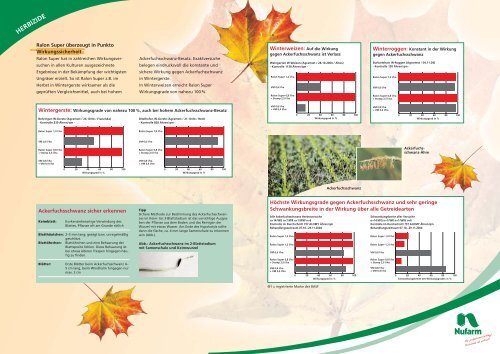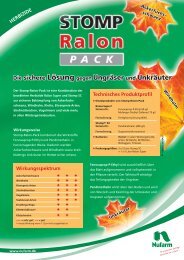ZULASSUNG - Ralon Super PowerPlus
ZULASSUNG - Ralon Super PowerPlus
ZULASSUNG - Ralon Super PowerPlus
Sie wollen auch ein ePaper? Erhöhen Sie die Reichweite Ihrer Titel.
YUMPU macht aus Druck-PDFs automatisch weboptimierte ePaper, die Google liebt.
<strong>Ralon</strong> <strong>Super</strong> überzeugt in Punkto<br />
Wirkungssicherheit<br />
<strong>Ralon</strong> <strong>Super</strong> hat in zahlreichen Wirkungsversuchen<br />
in allen Kulturen ausgezeichnete<br />
Ergebnisse in der Bekämpfung der wichtigsten<br />
Ungräser erzielt. So ist <strong>Ralon</strong> <strong>Super</strong> z.B. im<br />
Herbst in Wintergerste wirksamer als die<br />
geprüften Vergleichsmittel, auch bei hohem<br />
Ackerfuchsschwanz-Besatz. Exaktversuche<br />
belegen eindrucksvoll die konstante und<br />
sichere Wirkung gegen Ackerfuchsschwanz<br />
in Wintergerste.<br />
In Winterweizen erreicht <strong>Ralon</strong> <strong>Super</strong><br />
Wirkungsgrade von nahezu 100 %.<br />
Winterweizen: Auf die Wirkung<br />
gegen Ackerfuchsschwanz ist Verlass<br />
Weingarten W-Weizen (Agrartest / 28.10.2004 / Altos)<br />
- Kontrolle 1138 Ähren/qm -<br />
<strong>Ralon</strong> <strong>Super</strong> 1,2 l/ha<br />
VM 0,6 l/ha<br />
<strong>Ralon</strong> <strong>Super</strong> 0,8 l/ha<br />
+ Stomp 2,5 l/ha<br />
Winterroggen: Konstant in der Wirkung<br />
gegen Ackerfuchsschwanz<br />
Burkartshain W-Roggen (Agrartest / 04.11.04)<br />
- Kontrolle 150 Ähren/qm -<br />
<strong>Ralon</strong> <strong>Super</strong> 1,2 l/ha<br />
VM 0,6 l/ha<br />
<strong>Ralon</strong> <strong>Super</strong> 0,8 l/ha<br />
+ Stomp 2,5 l/ha<br />
Wintergerste: Wirkungsgrade von nahezu 100 %, auch bei hohem Ackerfuchsschwanz-Besatz<br />
Behringen W-Gerste (Agrartest / 24.10.04 / Franziska)<br />
- Kontrolle 239 Ähren/qm -<br />
Ditelhofen W-Gerste (Agrartest / 21.10.04 / Reni)<br />
- Kontrolle 820 Ähren/qm -<br />
VM 0,8 l/ha<br />
+ VM 0,4 l/ha<br />
0 20 40 60 80 100<br />
Wirkungsgrad in %<br />
VM 0,8 l/ha<br />
+ VM 0,4 l/ha<br />
0 20 40 60 80 100<br />
Wirkungsgrad in %<br />
<strong>Ralon</strong> <strong>Super</strong> 1,0 l/ha<br />
<strong>Ralon</strong> <strong>Super</strong> 1,0 l/ha<br />
VM 0,6 l/ha<br />
<strong>Ralon</strong> <strong>Super</strong> 0,8 l/ha<br />
+ Stomp 2,5 l/ha<br />
VM 0,8 l/ha<br />
+ VM 0,4 l/ha<br />
VM 0,6 l/ha<br />
<strong>Ralon</strong> <strong>Super</strong> 0,8 l/ha<br />
+ Stomp 2,5 l/ha<br />
VM 0,8 l/ha<br />
+ VM 0,4 l/ha<br />
Ackerfuchsschwanz-Ähre<br />
0 20 40 60 80 100<br />
Wirkungsgrad in %<br />
0 20 40 60 80 100<br />
Wirkungsgrad in %<br />
Ackerfuchsschwanz<br />
Ackerfuchsschwanz sicher erkennen<br />
Keimblatt:<br />
Korkenzieherartige Verwindung des<br />
Blattes, Pflanze oft am Grunde rötlich<br />
Blatthäutchen: 2–5 mm lang; gesägt bzw. unregelmäßig<br />
geschlitzt.<br />
Blattöhrchen: Blattöhrchen und eine Behaarung der<br />
Blattspreite fehlen. Diese Behaarung ist<br />
bei etwas älteren Trespen hingegen häufig<br />
zu finden.<br />
Blätter: Erste Blätter beim Ackerfuchsschwanz 4–<br />
5 cm lang, beim Windhalm hingegen nur<br />
max. 2 cm<br />
Tipp<br />
Sichere Methode zur Bestimmung des Ackerfuchsschwanzes<br />
im Keim- bis 3-Blattstadium ist das vorsichtige Ausgraben<br />
der Pflanze aus dem Boden und das Reinigen der<br />
Wurzel mit etwas Wasser. Am Ende des Hypokotyls sollte<br />
dann die flache, ca. 4 mm lange Samenschale zu erkennen<br />
sein (Abb.).<br />
Abb.: Ackerfuchsschwanz im 2-Blattstadium<br />
mit Samenschale und Keimwurzel<br />
Höchste Wirkungsgrade gegen Ackerfuchsschwanz und sehr geringe<br />
Schwankungsbreite in der Wirkung über alle Getreidearten<br />
Alle Ackerfuchsschwanz Herbstversuche<br />
n=14/WG n=7/WR n=1/WW n=6<br />
Kontrolle im Durchschnitt 737 ALOMY Ähren/qm<br />
Behandlungszeitraum 07.10.–29.11.2004<br />
<strong>Ralon</strong> <strong>Super</strong> 1,0 l/ha<br />
<strong>Ralon</strong> <strong>Super</strong> 1,2 l/ha<br />
VM 0,6 l/ha<br />
<strong>Ralon</strong> <strong>Super</strong> 0,8 l/ha<br />
+ Stomp 2,5 l/ha<br />
VM 0,8 l/ha<br />
+ VM 0,4 l/ha<br />
0 20 40 60 80 100<br />
Wirkungsgrad in %<br />
Schwankungsbreite aller Versuche<br />
n=14/WG n=7/WR n=1/WW n=6<br />
Kontrolle im Durchschnitt 737 ALOMY Ähren/qm<br />
Behandlungszeitraum 07.10.–29.11.2004<br />
<strong>Ralon</strong> <strong>Super</strong> 1,0 l/ha<br />
<strong>Ralon</strong> <strong>Super</strong> 1,2 l/ha<br />
VM 0,6 l/ha<br />
<strong>Ralon</strong> <strong>Super</strong> 0,8 l/ha<br />
+ Stomp 2,5 l/ha<br />
VM 0,8 l/ha<br />
+ VM 0,4 l/ha<br />
0 20 40 60 80 100<br />
Schwankungsbreite des Wirkungsgrades in %<br />
®1 = registrierte Marke der BASF



